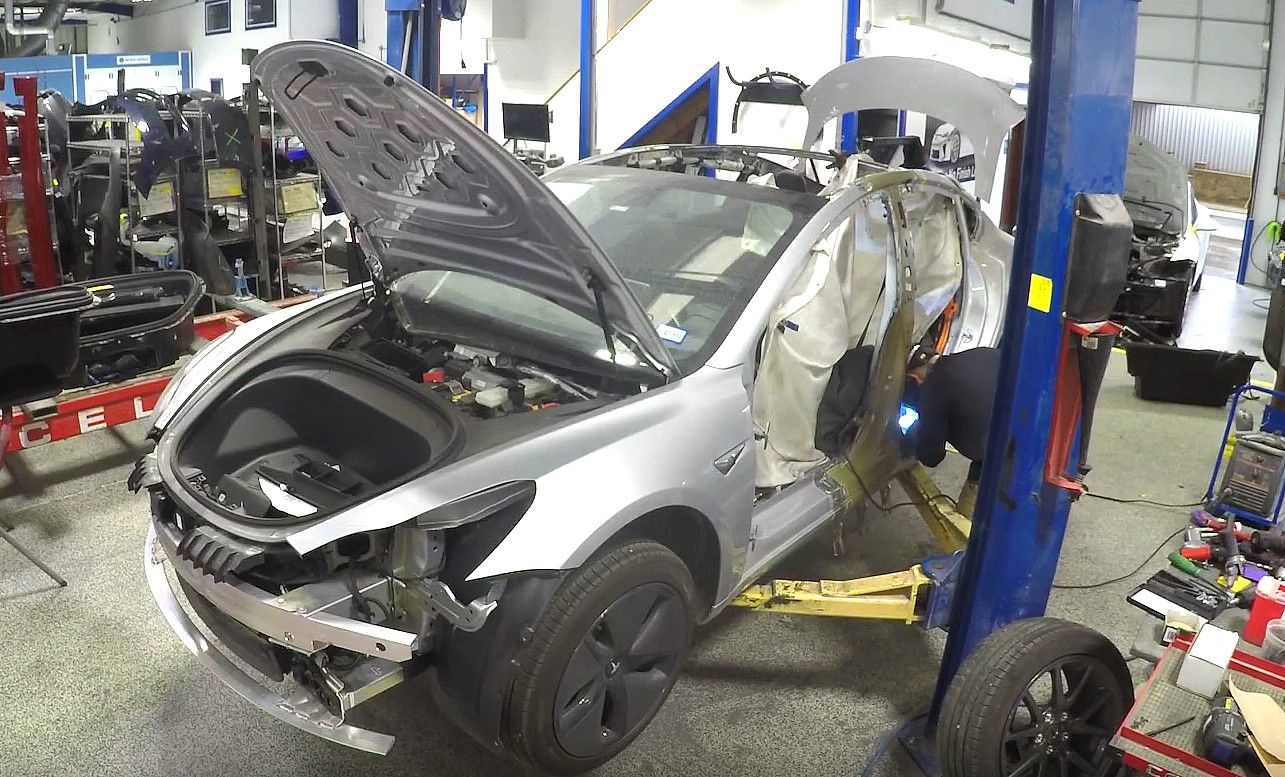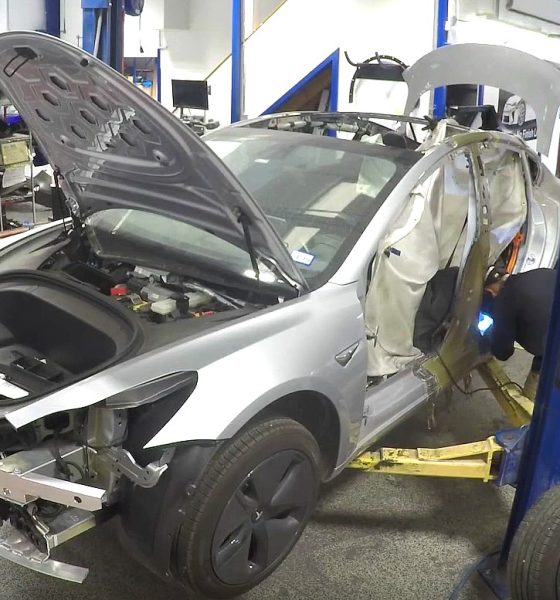

News
Tesla-approved body shop shares close look at Model 3 repair and restoration
A Tesla-certified body shop from Austin, TX recently provided a unique look at the work that goes behind the repair and restoration process of a Model 3 with a damaged B-Pillar. As could be seen in a time-lapse video of the Model 3’s repair, the team from the body shop spent several days refitting the electric car with OEM parts, restoring it to showroom condition before handing it over to its owner.
The team that handled the vehicle’s repair, Autocraft Bodywerks, has been fixing Teslas for years. The shop noted that the repair and restoration of a Tesla are not as simple as that of internal combustion vehicles, with the electric cars requiring specialized training in aluminum welding and adhesive and mechanical joining tech. This specialized training was in full view in the recently shared time-lapse footage, as the Autocraft team could be seen carefully working on the vehicle to return it to its original state.
The Model 3 featured in the video was a Long Range variant that was involved in a traffic accident last October. The electric car was T-boned right in the middle during the incident, damaging the left side B-Pillar, as well as the left front and left rear doors. The entire repair procedure took a considerable amount of time, from the removal of the damaged pillar to the complete reassembly of the vehicle. Reassembly was no joke either, with the Tesla-certified body shop putting back the vehicle piece by piece, from its doors to its glass roof.
Considering that the Model 3 was T-boned late last year, the entire repair process still took a considerable amount of time. Autocraft Bodywerks noted that they only used OEM parts for the vehicle’s restoration, which could have contributed to the extended repair time for the Model 3. Tesla, for its part, has been pledging to improve its vehicles’ repair times, mainly as its fleet is currently growing at an unprecedented pace due to the Model 3’s ramp.
Tesla’s vehicles are among the safest on the road, with the company’s entire lineup being awarded stellar safety ratings from agencies like the National Highway Traffic Safety Administration (NHTSA). Among the factors that contributed to these ratings are the vehicles’ bodies, which are primarily made of aluminum. Aluminum has several advantages over common materials used in cars such as steel, such as lighter weight and great energy absorption during impacts, but the material is also notoriously difficult to work with. Thus, Tesla requires body shops such as Autocraft to undergo training and certification before they were greenlighted to perform repairs on the company’s vehicles.
Elon Musk has pledged to make the repair process of Tesla’s vehicles a lot faster and smoother, even noting that the company is aiming to achieve 24-hr turnaround times for vehicle repairs. Tesla has already accomplished these feats for minor repairs at its in-house body shops, though the program is yet to see a wide rollout. The company has also noted that it is doubling its service capacity this year to accommodate more vehicles.
Watch a Model 3 undergo a complete restoration in the time-lapse video below.

News
Tesla FSD fleet is nearing 7 billion total miles, including 2.5 billion city miles
As can be seen on Tesla’s official FSD webpage, vehicles equipped with the system have now navigated over 6.99 billion miles.

Tesla’s Full Self-Driving (Supervised) fleet is closing in on almost 7 billion total miles driven, as per data posted by the company on its official FSD webpage.
These figures hint at the massive scale of data fueling Tesla’s rapid FSD improvements, which have been quite notable as of late.
FSD mileage milestones
As can be seen on Tesla’s official FSD webpage, vehicles equipped with the system have now navigated over 6.99 billion miles. Tesla owner and avid FSD tester Whole Mars Catalog also shared a screenshot indicating that from the nearly 7 billion miles traveled by the FSD fleet, more than 2.5 billion miles were driven inside cities.
City miles are particularly valuable for complex urban scenarios like unprotected turns, pedestrian interactions, and traffic lights. This is also the difference-maker for FSD, as only complex solutions, such as Waymo’s self-driving taxis, operate similarly on inner-city streets. And even then, incidents such as the San Francisco blackouts have proven challenging for sensor-rich vehicles like Waymos.
Tesla’s data edge
Tesla has a number of advantages in the autonomous vehicle sector, one of which is the size of its fleet and the number of vehicles training FSD on real-world roads. Tesla’s nearly 7 billion FSD miles then allow the company to roll out updates that make its vehicles behave like they are being driven by experienced drivers, even if they are operating on their own.
So notable are Tesla’s improvements to FSD that NVIDIA Director of Robotics Jim Fan, after experiencing FSD v14, noted that the system is the first AI that passes what he described as a “Physical Turing Test.”
“Despite knowing exactly how robot learning works, I still find it magical watching the steering wheel turn by itself. First it feels surreal, next it becomes routine. Then, like the smartphone, taking it away actively hurts. This is how humanity gets rewired and glued to god-like technologies,” Fan wrote in a post on X.
News
Tesla starts showing how FSD will change lives in Europe
Local officials tested the system on narrow country roads and were impressed by FSD’s smooth, human-like driving, with some calling the service a game-changer for everyday life in areas that are far from urban centers.

Tesla has launched Europe’s first public shuttle service using Full Self-Driving (Supervised) in the rural Eifelkreis Bitburg-Prüm region of Germany, demonstrating how the technology can restore independence and mobility for people who struggle with limited transport options.
Local officials tested the system on narrow country roads and were impressed by FSD’s smooth, human-like driving, with some calling the service a game-changer for everyday life in areas that are far from urban centers.
Officials see real impact on rural residents
Arzfeld Mayor Johannes Kuhl and District Administrator Andreas Kruppert personally tested the Tesla shuttle service. This allowed them to see just how well FSD navigated winding lanes and rural roads confidently. Kruppert said, “Autonomous driving sounds like science fiction to many, but we simply see here that it works totally well in rural regions too.” Kuhl, for his part, also noted that FSD “feels like a very experienced driver.”
The pilot complements the area’s “Citizen Bus” program, which provides on-demand rides for elderly residents who can no longer drive themselves. Tesla Europe shared a video of a demonstration of the service, highlighting how FSD gives people their freedom back, even in places where public transport is not as prevalent.
What the Ministry for Economic Affairs and Transport says
Rhineland-Palatinate’s Minister Daniela Schmitt supported the project, praising the collaboration that made this “first of its kind in Europe” possible. As per the ministry, the rural rollout for the service shows FSD’s potential beyond major cities, and it delivers tangible benefits like grocery runs, doctor visits, and social connections for isolated residents.
“Reliable and flexible mobility is especially vital in rural areas. With the launch of a shuttle service using self-driving vehicles (FSD supervised) by Tesla in the Eifelkreis Bitburg-Prüm, an innovative pilot project is now getting underway that complements local community bus services. It is the first project of its kind in Europe.
“The result is a real gain for rural mobility: greater accessibility, more flexibility and tangible benefits for everyday life. A strong signal for innovation, cooperation and future-oriented mobility beyond urban centers,” the ministry wrote in a LinkedIn post.
News
Tesla China quietly posts Robotaxi-related job listing
Tesla China is currently seeking a Low Voltage Electrical Engineer to work on circuit board design for the company’s autonomous vehicles.

Tesla has posted a new job listing in Shanghai explicitly tied to its Robotaxi program, fueling speculation that the company is preparing to launch its dedicated autonomous ride-hailing service in China.
As noted in the listing, Tesla China is currently seeking a Low Voltage Electrical Engineer to work on circuit board design for the company’s autonomous vehicles.
Robotaxi-specific role
The listing, which was shared on social media platform X by industry watcher @tslaming, suggested that Tesla China is looking to fill the role urgently. The job listing itself specifically mentions that the person hired for the role will be working on the Low Voltage Hardware team, which would design the circuit boards that would serve as the nervous system of the Robotaxi.
Key tasks for the role, as indicated in the job listing, include collaboration with PCB layout, firmware, mechanical, program management, and validation teams, among other responsibilities. The role is based in Shanghai.
China Robotaxi launch
China represents a massive potential market for robotaxis, with its dense urban centers and supportive policies in select cities. Tesla has limited permission to roll out FSD in the country, though despite this, its vehicles have been hailed as among the best in the market when it comes to autonomous features. So far, at least, it appears that China supports Tesla’s FSD and Robotaxi rollout.
This was hinted at in November, when Tesla brought the Cybercab to the 8th China International Import Expo (CIIE) in Shanghai, marking the first time that the autonomous two-seater was brought to the Asia-Pacific region. The vehicle, despite not having a release date in China, received a significant amount of interest among the event’s attendees.








